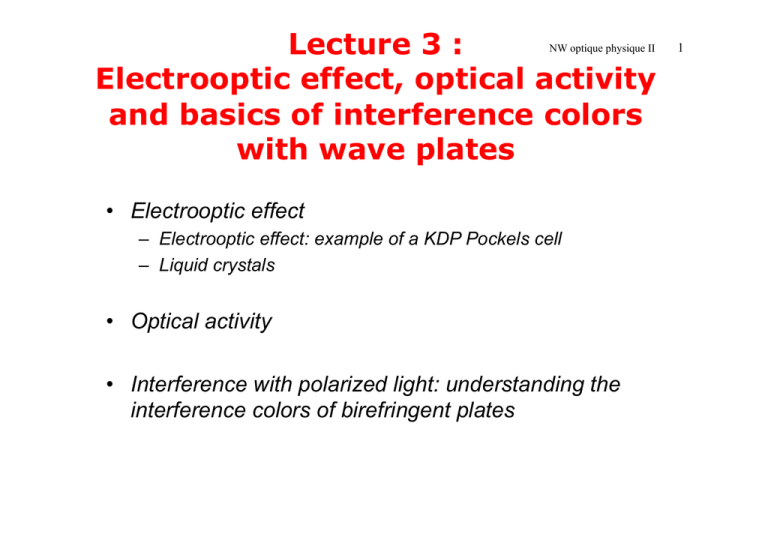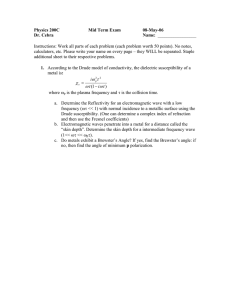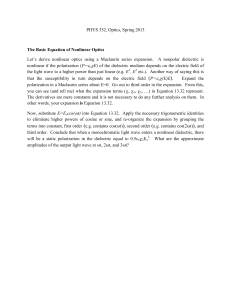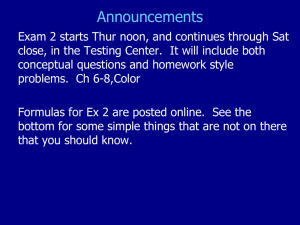Lecture 3 : Electrooptic effect, optical activity and basics of
advertisement

Lecture 3 : Electrooptic effect, optical activity and basics of interference colors with wave plates NW optique physique II • Electrooptic effect – Electrooptic effect: example of a KDP Pockels cell – Liquid crystals • Optical activity • Interference with polarized light: understanding the interference colors of birefringent plates 1 NW optique physique II 2 1 – Electrooptic effect Principle Anisotropy can be induced by external fields: We will consider here only the effect of an electric field Electrooptic effect In general induced index changes are small and they require high fields or large path lengths However technological advances allow strong effects using low fields (liquid crystals, electrooptic waveguides for telecoms,…) NW optique physique II 3 • All necessary tools have been seen in the case of natural anisotropy, we only need now to connect the characteristic eigen indices of the material to the applied external field • This lecture will provide a few examples of existing effects and their applications, other courses such as « Guided and Coupled Waves » by Jean-Michel Jonathan will go over this subject in more details • Numerous technological applications to these induced optical effects NW optique physique II 4 I. Electro-optical Effects Modification of the index ellipsoïd We can characterize the effect of the E field by the modification of the index ellipsoid (n in the direction of D): 2 2 2 x 2 n xx + y 2 n yy z 2yz 2xz 2xy + 2 + 2 + 2 + 2 =1 n zz n yz n xz n xy Each 1/nij2 term may in general include • terms proportional to E : Pockels effect € • and terms in E2 : Kerr effect No linear terms in E if the medium is initially isotropic NW optique physique II 5 Pockels effect The transformation of the index ellipsoïd can be calculated from the electrooptic 3*6 matrix of the medium, according to the following relationship: ⎛ 1 1 ⎞ − ⎜ 2 2 ⎟ n n x ⎟ ⎜ xx ⎜ 1 − 1 ⎟ 2 ⎜ n yy n y2 ⎟ ⎛ r11 ⎜ ⎜ 1 1 ⎟ ⎜ r21 ⎜ 2 − 2 ⎟ n z ⎟ ⎜ r31 ⎜ n zz ⎜ 1 ⎟ = ⎜ r ⎜ 2 − 0 ⎟ ⎜ 41 ⎜ n yz ⎟ ⎜ r51 ⎜ 1 − 0 ⎟ ⎜⎝ r 61 ⎜ n 2 ⎟ ⎜ xz ⎟ 1 ⎜ ⎟ ⎜ n 2 − 0 ⎟ ⎝ xy ⎠ r12 r22 r32 r42 r52 r62 r13 ⎞ ⎟ r23 ⎟ ⎛ Ex ⎞ r33 ⎟ ⎜ ⎟ ⎟ ⎜ Ey ⎟ r43 ⎟ ⎜ ⎟ ⎝ Ez ⎠ r53 ⎟ ⎟ r63 ⎠ Matrix which characterizes the electrooptic response of the medium NW optique physique II Example: Pockels effect in KDP (see optics labs) Electro-optic tensor Section of the index ellipsoid Initially uniaxial with optic axis z y! Y X Applied field X E // z 2 2 ⎛ ⎞ ⎛ ⎞ z2 1 x+y 1 x−y + 2 + 2 + 2xyr63 E = 1 = 2 ⎜ ⎟ + 2 ⎜ ⎟ + 2 2 no no ne n X ⎝ 2 ⎠ nY ⎝ 2 ⎠ n e x2 € y2 z2 ⎡ 1 2 ⎤ n X = n o⎢1 − n o r63 E⎥ ⎣ 2 ⎦ ⎡ 1 2 ⎤ nY = n o⎢1 + n o r63 E⎥ ⎣ 2 ⎦ For a propagation along z ϕ= 2π 2π 3 (nY − n X )e = n o r63V λ λ 6 NW optique physique II The direction of the new axes can also depend on the electric field Same example of KDP but different direction of applied E Applied field Electro-optic tensor E // y x2 n o2 + y2 n o2 + z2 n e2 + 2xzr41E = 1 Section of the index ellipsoid z € β x β and Δn ∝ E 7 NW optique physique II Electrooptical effect: the case of liquid crystals α E V=0 V Birefringence Birefringence ↓ when α ↑ (ie V ↑) Optical axis // molecules α = 90° → no more birefringence 8 NW optique physique II Applications of the electrooptical effect • Modulators: polarization states or intensity • Deflectors • Phase shifters • Displays • Optical switches Modulation frequencies can be very high, up to a few GHz (not for liquid crystals, which are slower) 9 NW optique physique II 10 2 – Optical activity A linear polarization is rotated by an angle α: • proportional to the path length through the medium • proportional to the concentration (for a solution) • dependent on wavelength as 1/λ2 Certain substances cause a left handed rotation (levorotatory), other a right handed rotation (dextrorotatory) with respect to the observer. A mixture with equal concentrations (racemic) does not produce any rotation. Examples of optically active media Cristalline quartz, used with light propagating in the direction of its optical axis Nicotine, turpentine, camphor, sugar in solution, etc. Microscopic origin: the atomic arrangement in the molecule is asymmetric, the molecule is not identical to its image in a mirror (for quartz it is an asymmetry in the crystal structure) NW optique physique II Interpretation in terms of circular birefringence In terms of the modification induced on a polarization state, wwe can interpret optical activity as a phase shift induced between the left handed and right handed circular eigen polarizations : α = (ϕR-ϕL)/2=π/λ(nR-nL)e Note that for quartz the circular birefringence is 128 times smaller than the linear birefringence (ne-no) Applications • Sugar concentration measurement (saccharimetry): 100°Z=34,626° (for λ=589,44nm) for 26g of sucrose in 100ml for a thickness of 200mm • Dose or control of purity for different substances in the food industry, pharmaceutical, cosmetic and chemical industries • Penumbra analyzer: Soleil biquartz 11 NW wave optics (polarization) 3 – Interference with polarized light Main properties of two wave interference • Two wave interference: superposition of two fields with a phase shift • Shape of the fringes: dark fringes for • Best contrast for equal intensities of the two beams NW wave optics (polarization) Interference with polarized waves With polarized light E1 et E2 are complex amplitudes: • The interference term 2Re(E1*.E2.eiϕ) is zero if the two polarizations are orthogonal • In the case of linear polarizations (E1 and E2 real vectors), the interference term becomes 2 E1.E2cosϕ • If E1//E2 we get back to the unpolarized case: e.g. a Michelson interferometer with incident light TE or TM, the only dependance with polarization comes from the Fresnel coefficients R and T of the beamsplitter NW wave optics (polarization) Interference using birefringent media The amplitude of an incident wave is split between two waves: the ordinary and extraordinary waves CAN THEY INTERFERE? • In principle NO because the fields are orthogonal • BUT using a linear polarizer (called the « analyzer ») at the exit of the birefringent medium, the two fields are projected onto the same axis, that of the analyzer, and YES they can thus interfere NW wave optics (polarization) WHAT IS THE BEST POSITION FOR THE ANALYZER? Maximize the contrast The two interfering waves should have the same intensity so that the destructive interference is zero: Imin=0 Two possibilities • E1.E2>0 • E1.E2<0 The 2 fields after the analyzer must have the same amplitude (to within a sign) NW wave optics (polarization) IS THERE A BETTER CHOICE FOR THE INCIDENT POLARIZATION? YES, so that the constructive interference has an intensity that is maximum α : angle between the incident polarization and the neutral axes (ordinary and extraordinary) of the birefringent medium: We already have (max contrast) Maximum intensity: Imax is maximum for α=45° NW wave optics (polarization) BEST POLARIZATION CONDITION FOR INTERFERENCE In conclusion two situations maximize both contrast and intensity: the birefringent medium should be placed between a polarizer P and an analyzer A such that : 1. P and A parallel and at 45° of the neutral axes 2. P and A orthogonal and at 45° of the neutral axes NW wave optics (polarization) • In both cases, Iin is the intensity arriving on the birefringent medium, i.e. after the first polarizer. • P and A orthogonal is often a better choice because the contrast is always maximum even if the neutral axes are not at 45° • Interference does not always imply « fringes » : if the birefringent medium is a simple plate with plane parallel sides, is uniform over the whole observation field; the interference results is a uniform intensity (no fringes) as for a Michelson with an incident plane wave NW wave optics (polarization) Observation of fringes with a small angle Wollaston prism Small angle θ ⇒we neglect the ray deviation x θ δ=2(ne-no)xθ Straight fringes // y axis y Dark fringe (if P ⊥ A) for x=0 Observation on the slide projector P A with green light + parallel or crossed polarizers : 10 fringes over 30mm*30mm of quartz ⇒ Calculate the angle θ NW wave optics (polarization) Application to the measurement of the phase shift of a wave plate: Babinet compensator We add the unknown phase plate with its axes parallel to the Wollaston’s axes The plate induces a translation of the fringes by δplate/λ*period of the fringes Unknown plate P A NW wave optics (polarization) Babinet compensator We can translate one prism of the Wollaston to bring back the central fringe at x=0 d Babinet translated by d to bring back the dark fringe at the center (P ⊥ A): δplate=(ne-no)dθ Unknown plate P A NW wave optics (polarization) Interference with white light : Newton’s color scale and channeled spectrum The phase ϕ varies because of the different λ. We neglect the dependence of ne-no with λ. Observation with the naked eye → superposition of different I(λ) → Resultant color if δ is not too large NW wave optics (polarization) δ in nm NW wave optics (polarization) NW wave optics (polarization) Interference with white light : Newton’s color scale White fringe at the center for P//A, dark fringe for P⊥A Advantage of the sensitive color (purple): sensitivity <100nm Esay to observe in polarized light because δ=(ne-no)e is small → observation on the slide projector with layers of scotch tape Channeled spectrum Observation with spectrometer → dispersion of the different λ P//A: dark fringes if δ=λ/2+kλ P⊥A: dark fringes si δ=kλ



